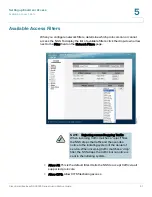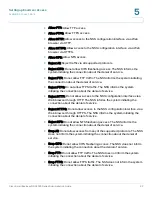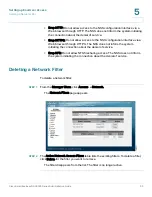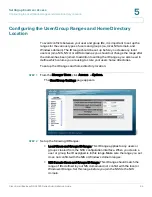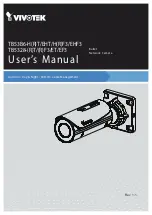
Setting up End-User Access
Managing Volume Quotas
Cisco Small Business NSS2000 Series Administration Guide
79
5
Managing Volume Quotas
You can set up specific space limits for each user or group who has write access
to a volume. Defining a user or group’s quota means that you can set a space limit
(referred to as a soft quota) that, when reached, sends a warning to the
administrator and initiates a countdown of the defined grace period. The user has
the amount of time in the grace period to reduce the amount of space used to
under the soft quota limit. Users who do not reduce the space in the allotted grace
period, or who reach their hard quota limit, no longer have write access to the
volume until they reduce their usage to under their soft quota limit.
When a user creates, modifies or deletes a file on a volume, note that there is a
small delay before the usage is updated on the Filesystem Quota page. This delay
is due to the caching in the filesystem used to provide high performance.
Changing the User’s Primary Group
Quotas are charged to the group assigned as the user’s primary group at the time
of file creation. If the user’s primary group changes, files created under the
previous group continue to be charged against that group. Note that if the user’s
primary group changes while the user is connected to the NSS, the previous
primary group continues to be the group charged until the user’s connection is
closed. The new primary group becomes the group charged only after the
connection is re-opened.
NOTE:
Before you create or edit a quota
located on an encrypted volume, make sure the
volume is unlocked. You also need to set up the
Warn For time for each volume from the
Filesystem Quota page. The Warn For time only
affects individual quota that was created after
the Warn For time was set.
NOTE:
If the user is created within a domain,
the primary group defined is in the user profile
from the domain, not the Primary Group field in
the NSS user profile.



























